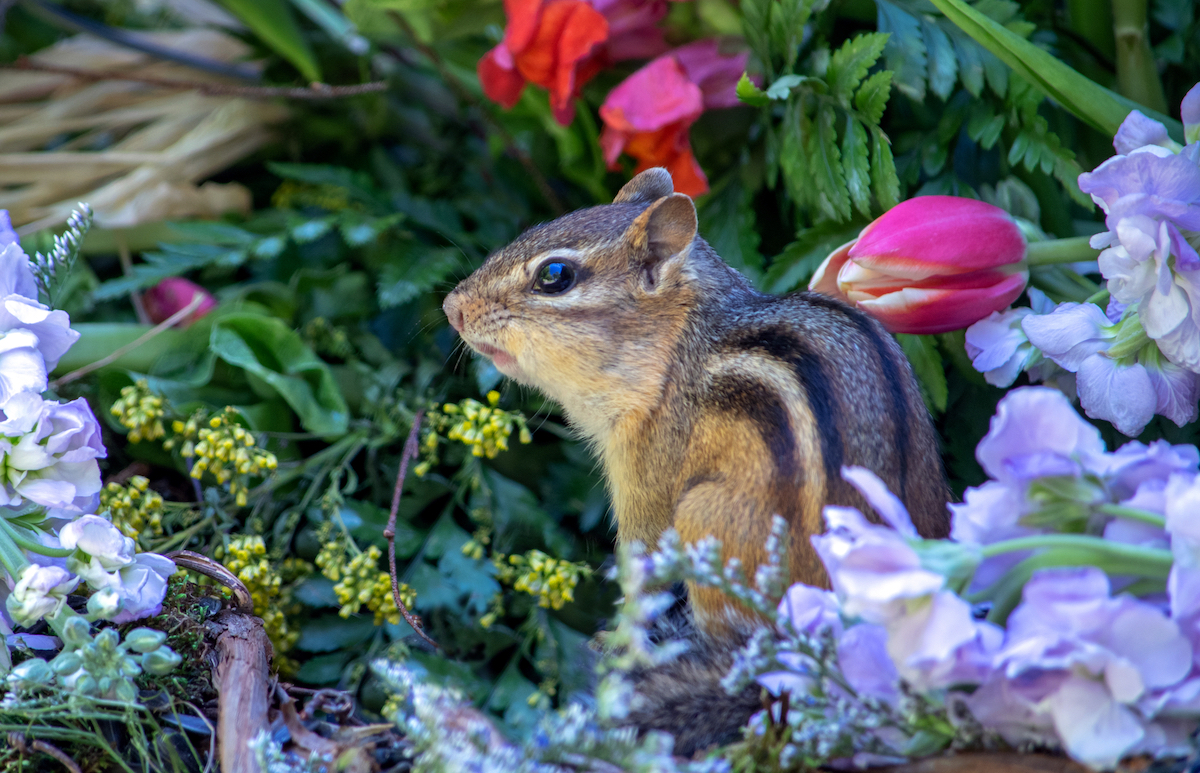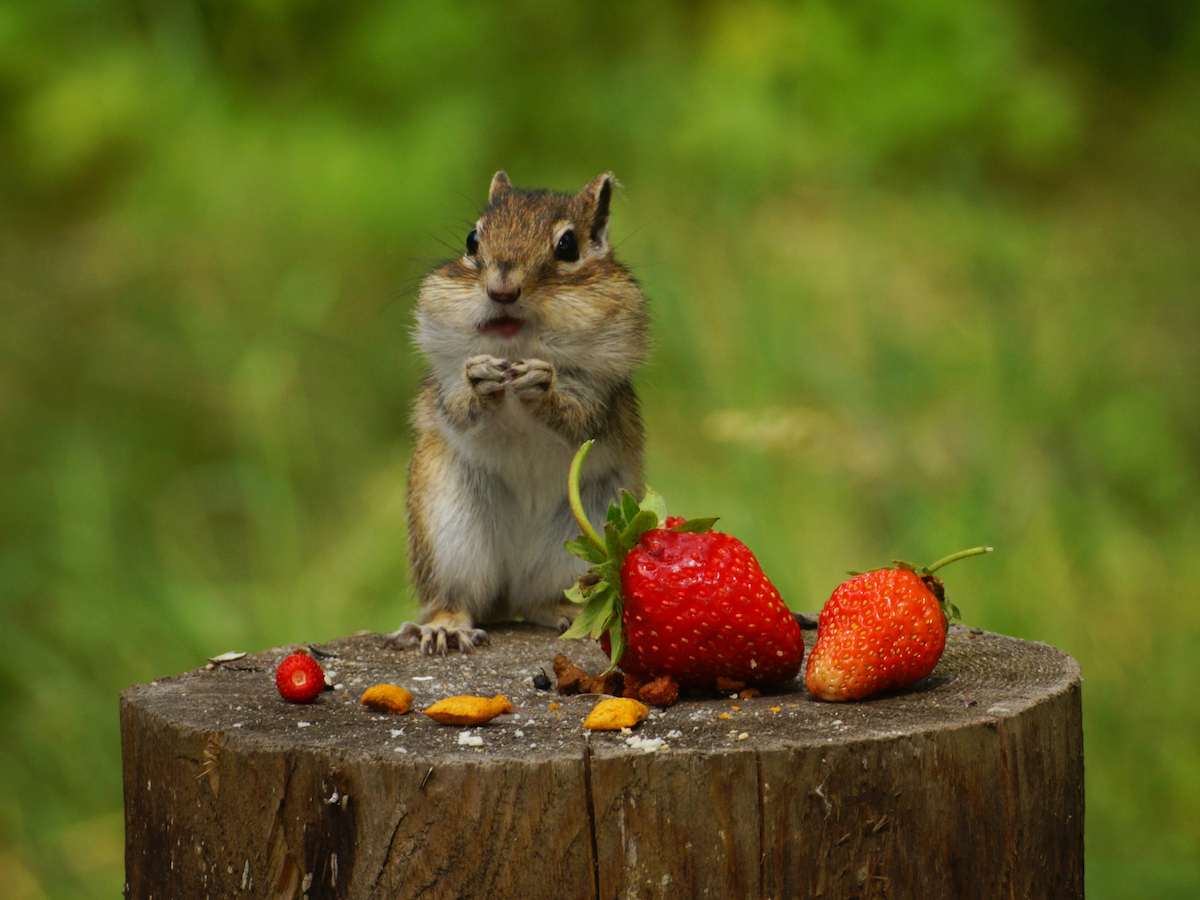

We may earn revenue from the products available on this page and participate in affiliate programs. Learn More ›
Surely one of the cuter rodents you’ll ever counter, chipmunks are also among the most destructive. These small, striped natives of North America and Asia are omnivores that devour everything from beneficial insects to buds, bulbs, and other garden plantings. Potentially worse, while they run like lightning to avoid humans, their underground burrows can destabilize the foundation of your house.
Fortunately, you can discourage and, if necessary, humanely remove the critters from your property. Start with simple, natural deterrents and proceed to stricter yet still humane measures to send the little guys packing. Below, you’ll find five key strategies for how to get rid of chipmunks running around in your yard.
Look for signs of chipmunks on your property.
Chipmunks are so shy and so quick, you may not even notice them in your yard, though they’re most active during daytime hours. But if you’ve seen evidence of munching in your garden, start sleuthing. Look for “tiny holes in lawns and trails, typically in the midst of a route or walkway, next to the home’s foundation, and along the edge,” says Eddie Martin, CEO, Private Exterminating, based in Brooklyn, New York. You might also see tiny footprints (four toes in front, five in back), and piles of seed shells under your birdfeeder. Look for chipmunk droppings, which are dark, elongated bits that look like rice or beans. Note that chipmunks do not live communally; each chipmunk digs and lives in its own burrow. Once you’ve confirmed you have chipmunks, you can determine how to get rid of chipmunks on your property.

Tried-and-True Advice
“I find that chipmunks are particularly attracted to flower bulbs in fall since they’re packed with nutrients and easy to transport back to chipmunk burrows. In years past, I’ve actually seen chipmunks scavenging in areas where I just planted bulbs, so now I’m pretty vigilant about protecting my flower bulbs after planting.
I use bulb cages to protect individual flowering bulbs, but I also sometimes bury sheets of hardware cloth below and above full beds of bulbs to prevent chipmunks and other rodents from causing trouble. I find this is a more cost-effective way to protect larger plantings of bulbs and it’s effective against voles, mice, and rats too. It’s also a good idea to clean up plant debris like bulb skins after planting. Skip using smelly products like bone meal and fish emulsion in planting holes, as these products can sometimes attract chipmunks.”
—Lauren Landers, Contributing Writer
Roll up the welcome mat.

To make your property unattractive to chipmunks, keep your garden tidy by cleaning up windfall from fruit trees and berry bushes. Also, consider putting in plants like garlic and daffodils that act as natural repellents. “Clear yards of brush, wood piles, and debris where chipmunks can hide or build nests,” says Peter Rania, CEO of Waltham Pest Control in Burlington, Massachusetts. Keep bird feeders high off the ground and away from fences, porch banisters, and other potential chipmunk paths. To discourage the critters from approaching your home’s foundation, avoid shrubs and low rock boundaries near the house, which provide shelter and transportation for critters. “Fill in any holes or cracks leading into attics or under porches,” Rania adds.
Squirrels can also take up residence in your attic. Discourage this by installing “a one-way door or trap,” says Rania. Be sure to remove all chipmunks from attic spaces before you “seal up entry holes to prevent re-infestation,” he adds.
Use a combination of chipmunk repellents.
When thinking about how to get rid of chipmunks, consider that there are four main types of chipmunk repellents, which can be used together and for different purposes:
- Natural repellents: Ask your barber or hairstylist for a bag of hair clippings and sprinkle these around your garden. The human smell frightens chipmunks and other pests away yet is perfectly harmless—in fact, the nitrogen in human hair breaks down slowly and may offer your plants a natural fertilizer boost, according to a study by Mississippi State University that was published in the journal HortTechnology.
- Electronic repellents: An electronic repellent system uses ultrasonic pulses or sprays of water to get rid of chipmunks as well as deer, raccoons, rabbits, and various types of squirrels that may be drawn to your lawn. A high-quality, non-toxic, and top-rated electronic pest repeller costs $20 to $30 and can cover 90-1,200 square feet via a safe, consistent power source: typically an AC 110 volt plug outlet or AA batteries. Keep in mind, however, that sound waves and water sprays won’t dislodge chipmunk nests and burrows underground.
- Liquid repellents: Purchase a nontoxic commercial product like Exterminators Choice Rodent Defense Spray or make a DIY solution of one quart of water boiled with two tablespoons of cayenne to repel chipmunks. Once cool, add two tablespoons of olive oil to this deterrent for chipmunks. Store in a labeled spray bottle and shake well before spraying directly on infested areas. Reapplication and patience are essential, as it may take a bit of time (and favorable weather conditions) for chipmunks to come into direct contact with the distasteful stuff. Fall gardening tip: Protect vulnerable tulip bulbs from snacking chipmunks by dipping them into a liquid repellent before planting.
- Dry repellents: Dry products are longer-lasting than liquid sprays and will help prevent chipmunk burrowing. Create barriers to access by sprinkling granular repellents in key areas. Use a product like Shake Away—which doesn’t kill chipmunks or other pests—in attics, near house foundations, around flower beds, and along garden paths. Or simply shake a healthy sprinkle of cayenne pepper—a natural chipmunk repellent—on affected areas.
Enforce good fencing.
The Humane Society suggests finding gentler ways of living with chipmunks while preventing them from nibbling our plants. Consider installing an L-shaped barrier of mesh fencing around the base of foundations, fences, porches, and other walls. Choose a gravel border instead of box shrubs. Protect flower bulbs by planting them in bulb cages, available at home centers and gardening supply stores.
Try trapping them.

Humane traps catch chipmunks without killing them so you can then ”release them at least 1/2 mile away from the capture site,” says Rania. Choose one- or two-door traps, typically 10 to 20 inches long, for chipmunks. (One-door traps tend to be simpler to operate and are often used by professionals.) Wear gloves when setting the traps, as any hint of human scent will spook your quarry. While chipmunks aren’t typically aggressive, they will bite if they feel threatened, and they can carry diseases such as plague, salmonella, and hantavirus.
Trap chipmunks in areas you’ve identified as prime chipmunk territory: your attic, garden shed, along fences and walls, and near the house foundations. Peanuts, sunflower seeds, and peanut butter make excellent bait, which you place directly on the trigger plate. Set the trap according to instructions and check it often so you can release the rodents promptly. After you’ve removed the chipmunks, you can fill in their holes with dirt or sand.
Note: Different localities have varying laws about trapping and relocating wild animals, so double-check your city’s wildlife ordinances first before using traps to get rid of the chipmunks running loose in your lawn.
